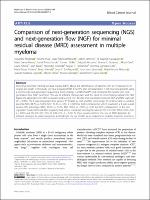Comparison of next-generation sequencing (NGS) and next-generation flow (NGF) for minimal residual disease (MRD) assessment in multiple myeloma

View
Author
Date
2020-10-30Permanent link
https://hdl.handle.net/11351/6281DOI
10.1038/s41408-020-00377-0
ISSN
2044-5385
WOS
000588057900002
PMID
33127891
Abstract
Detecting persistent minimal residual disease (MRD) allows the identification of patients with an increased risk of relapse and death. In this study, we have evaluated MRD 3 months after transplantation in 106 myeloma patients using a commercial next-generation sequencing (NGS) strategy (LymphoTrack®), and compared the results with next-generation flow (NGF, EuroFlow). The use of different marrow pulls and the need of concentrating samples for NGS biased the applicability for MRD evaluation and favored NGF. Despite that, correlation between NGS and NGF was high (R2 = 0.905). The 3-year progression-free survival (PFS) rates by NGS and NGF were longer for undetectable vs. positive patients (NGS: 88.7% vs. 56.6%; NGF: 91.4% vs. 50%; p < 0.001 for both comparisons), which resulted in a 3-year overall survival (OS) advantage (NGS: 96.2% vs. 77.3%; NGF: 96.6% vs. 74.9%, p < 0.01 for both comparisons). In the Cox regression model, NGS and NGF negativity had similar results but favoring the latter in PFS (HR: 0.20, 95% CI: 0.09–0.45, p < 0.001) and OS (HR: 0.21, 95% CI: 0.06–0.75, p = 0.02). All these results reinforce the role of MRD detection by different strategies in patient prognosis and highlight the use of MRD as an endpoint for multiple myeloma treatment.
Keywords
Myeloma; Risk factorsBibliographic citation
Medina A, Puig N, Flores-Montero J, Jimenez C, Sarasquete ME, Garcia-Alvarez M, et al. Comparison of next-generation sequencing (NGS) and next-generation flow (NGF) for minimal residual disease (MRD) assessment in multiple myeloma. Blood Cancer J. 2020 Oct 30;10:108.
Audience
Professionals
This item appears in following collections
- HVH - Articles científics [4476]
The following license files are associated with this item:

 Private area
Private area Contact Us
Contact Us






